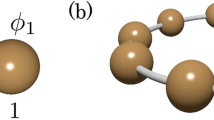Abstract
A model consisting of an array of flexible self-avoiding domain walls extending across a two-dimensional medium is considered. Adsorption phenomena in the presence of edgepinning forces and rupture, segregation, and order-disorder transitions due to shortrange attractive and repulsive interactions between the domain walls are studied using fermion transfer-matrix methods.
Similar content being viewed by others
References
Gennes, P.G. de: J. Chem. Phys.48, 2257 (1968)
Pokrovski, V.L., Talapov, A.L.: Phys. Rev. Lett.42, 65 (1979); Sov. Phys. JETP51, 134 (1980)
Schulz, H.J.: Phys. Rev. B22, 5274 (1980)
Okwamoto, Y.: J. Phys. Soc. Jpn.49, 8 (1980)
Luther, A., Timonen, J., Pokrovsky, V.L.: Phase transitions in surface films. Dash, J.G., Ruvalds, J. (eds.). New York: Plenum Press 1980
Villain, J.: Ordering in strongly fluctuating condensed matter systems. Riste, T. (ed.). New York: Plenum Press 1980
Villain, J., Bak, P.: J. Phys. (Paris)42, 657 (1981)
Haldane, F.D.M., Villain, J.: J. Phys. (Paris)42, 1673 (1981)
Ostlund, S.: Phys. Rev. B24, 398 (1981)
Abraham, D.B.: Phys. Rev. Lett.44, 1165 (1980)
Burkhardt, T.W.: J. Phys. A14, L63 (1981)
Chalker, J.T.: J. Phys. A14, 2431 (1981)
Chui, S.T., Weeks, J.D.: Phys. Rev. B23, 2438 (1981)
Kroll, D.M.: Z. Phys. B — Condensed Matter41, 345 (1981)
van Leeuwen, J.M.J., Hilhorst, H.J.: Physica107 A, 319 (1981)
Kroll, D.M., Lipowsky, R.: Phys. Rev. B26, 5289 (1982)
de Oliviera, M.J., Griffiths, R.B.: Surf. Sci.71, 687 (1978)
Pandit, R., Schick, M., Wortis, M.: Phys. Rev. B26, 5112 (1982)
Schulz, H.J.: Phys. Rev. Lett.46, 1685 (1981)
Rys, F.S.: Phys. Rev. Lett.51, 849 (1983)
Blöte, H.W.J., Hilhorst, H.J.: J. Phys. A15, L631 (1982)
There is no unique way to approximate\(\hat T\) in terms of a quadratic fermion Hamiltonian. Other choices, such as\(\hat T = 1 + \Sigma c_{x'}^ + \left\langle {x'\left| t \right|x} \right\rangle c_x \), which gives the matrix elements exactly in the case of a single domain wall, lead to a sequence of transitions with thesame qualitative characteristics, i.e. discontinuities in the specific heat. This second choice for\(\hat T\) only permits no kinks or one kink in alln domain walls betweeny andy+1, whereas (2.6) allows an arbitrary number of kinks in each wall, weighted in a particular way. Thus (2.5)–(2.6) replace the original model by another in which the distance between the kinks of a domain wall is a continuous rather than a discrete variable
Fetter, A.L., Walecka, J.D.: Quantum theory of many-particle systems. New York: McGraw-Hill 1971
The transfer matrix\(\hat T = \exp ( - \hat H)\) with\(\hat H\) given by (3.1) does not correspond exactly to the underlying lattice model, as can be seen by expanding\(\hat T\) in powers of\(\hat H\) and considering the nonvanishing matrix elements term by term. There is only agreement to first order in exp(−J/k BT) andV 1. One hopes that the differences in the models in higher orders do not change the qualitative characteristics of the phase transitions, i.e. that the universality classes are the same
Luther, A., Peschel, I.: Phys. Rev. B12, 3908 (1975)
Luther, A.: Phys. Rev. B14, 2153 (1976)
des Cloizeaux, J., Gaudin, M.: J. Math. Phys.7, 1384 (1966)
Yang, C.N., Yang, C.P.: Phys. Rev.150, 321, 327 (1966); Phys. Rev.151, 258 (1966)
Haldane, F.D.M.: Phys. Rev. Lett.45, 1358 (1980)
Luttinger, J.M.: J. Math. Phys.4, 1154 (1963)
Mattis, D.C., Lieb, E.H.: J. Math. Phys.6, 304 (1965)
Luther, A.: Phys. Rev. B15, 403 (1977)
Schlottmann, P.: Phys. Rev. B15, 465 (1977)
Luther, A., Peschel, I.: Phys. Rev. B9, 2911 (1974)
Author information
Authors and Affiliations
Additional information
Heisenberg Fellow of the Deutsche Forschungsgemeinschaft
Rights and permissions
About this article
Cite this article
Burkhardt, T.W., Schlottmann, P. Edge pinning and internal phase transitions in a system of domain walls. Z. Physik B - Condensed Matter 54, 151–158 (1984). https://doi.org/10.1007/BF01388066
Received:
Issue Date:
DOI: https://doi.org/10.1007/BF01388066



